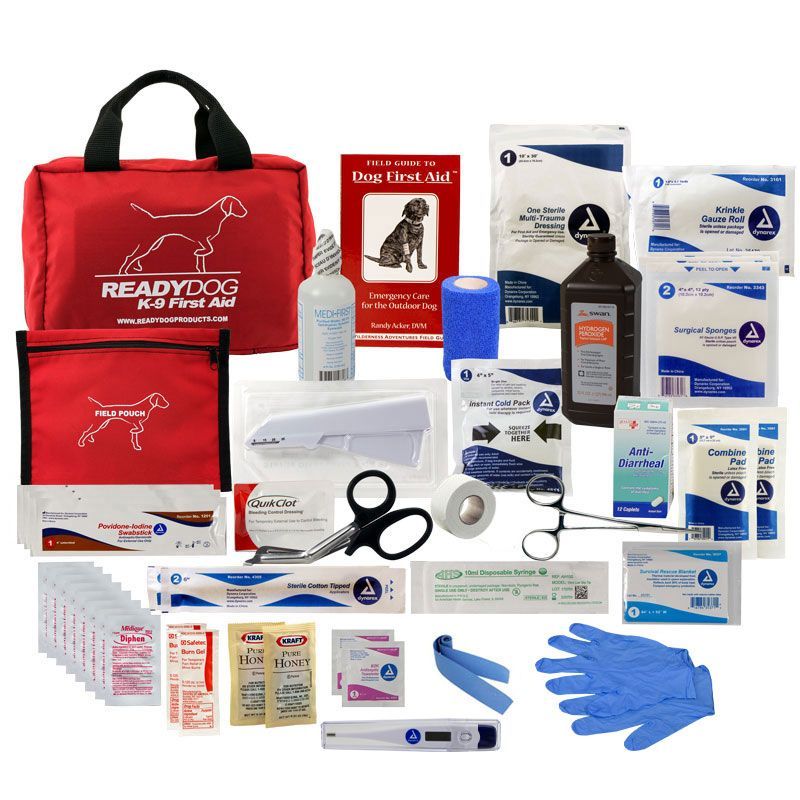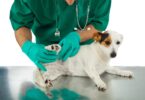Do you have a dog first aid kit? More importantly, if you have one, do you know how to use what’s inside of it? First aid kits treat minor injuries or help keep your dog stable until you can get them to their veterinarian or the closest animal hospital in case of an emergency.
You can buy kits that are already stocked with most of these items or you can just as easily make your own, which in our opinion is really the best dog first aid kit you can own and a must as part of your puppy checklist of things you need.
Contents
- 1 1. A First Aid Book
- 2 2. Cotton Balls
- 3 3. Self-Adhering Bandage Wrap
- 4 4. Tick Removal Tweezers
- 5 5. Gauze Pads/Squares & Rolls
- 6 6. Wound Spray
- 7 7. Elizabethan Collar
- 8 8. Saline Solution
- 9 9. Antihistamine
- 10 10. Latex Gloves
- 11 11. Hydrogen Peroxide
- 12 12. Ear & Rectal Thermometer
- 13 13. A Muzzle
- 14 14. Styptic Powder
- 15 Quick Recap & Dog CPR
1. A First Aid Book
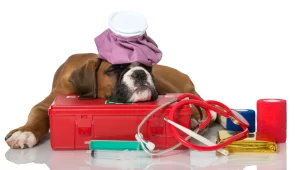
A first aid book is the best way to get quick answers if you’re out hiking, camping, at the dog park, or out of cell phone range.
I like to recommend to my friends: The First Aid Companion to Dogs & Cats by Amy D. Shoji. It’s a must have for any pet owner in my opinion.
A good first aid book will tell you the proper protocol in the event of something like an allergic reaction, a laceration, or a snake bite.
2. Cotton Balls 
Cotton balls have a variety of uses. You can use them to stop bleeding on small cuts or a nail that’s been cut too short, clean off eye boogers, or clean their ears. Anything that saves you from a trip to the vet is a plus.
3. Self-Adhering Bandage Wrap
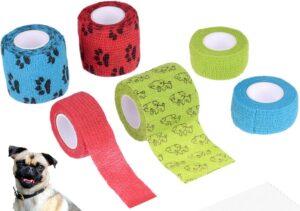
Rest easy little pug. This wrap is stretchy and sticks to itself but not skin or fur. It’s the final layer of a typical bandage and goes on over the rolled gauze.
4. Tick Removal Tweezers
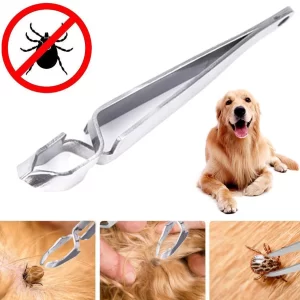 Similar to fleas, ticks are nasty little things.
Similar to fleas, ticks are nasty little things.
Forget the advice about removing ticks with a hot match. You should only remove ticks with specialized tweezers or have your veterinarian do it. If your dog just stays at home, you won’t necessarily need these tweezers, but if you’re a frequent hiker/camper or your area is heavily infested with ticks, you should definitely have a pair of these on hand.
They are designed to remove the head of the tick, while regular tweezers often break the head off and leave it imbedded in the skin. If Lyme disease is a common concern in your area, keep a small jar or ziplock bag on hand to save the tick and take it to your vet.
5. Gauze Pads/Squares & Rolls
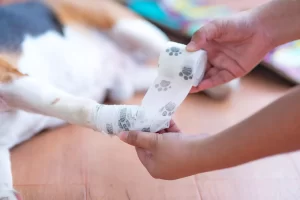
Gauze pads are great for stemming blood flow in the event of a major cut or injury. They can also be used underneath bandages to cover the wound. You can’t use sticky bandages on dogs, so the gauze rolls will be the first layer over the pad to keep it in place.
6. Wound Spray
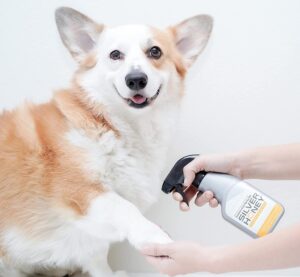
You shouldn’t apply wound spray to every injury on your dog, but it’s a good thing to have on hand if you know when to use it. If your dog is prone to hot spots, the spray will keep the wound clean and help reduce the associated itching.
7. Elizabethan Collar

Also known as e-collars or “the cone of shame“, they’re are necessary for dogs with stitches, bandages, or open wounds. They prevent the dog from licking or chewing areas that need to be left alone to heal.
8. Saline Solution
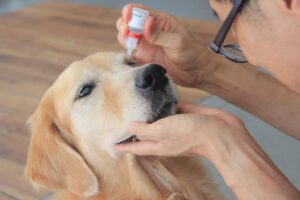
If your dog has eye irritation, you should never administer a medicated eye solution in case there’s a serious injury to the eyeball.
Saline solution is safe to use to flush the eye if they are particularly irritated from allergies. Saline is also good to flush wounds.
Tap water should never be used to clean out a wound or you’ll risk infection. Saline solution is sterile and safe to use.
9. Antihistamine

A rash on a dog’s paw. Also, can somebody please trim those nails?
Diphenhydramine is a safe and effective medication to treat allergic reactions in dogs. If your dog has a history of allergies and skin conditions, this is a necessity to have on hand. You should consult with your vet for proper dosing instructions and the right time to administer the drug.
10. Latex Gloves
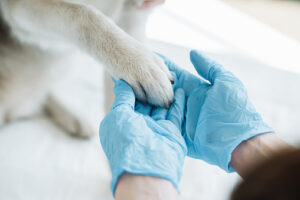
Ran out of medical latex gloves? Grab a bunch of household ones. They will work just as well.
Most DIY lists tell you it’s a good idea to have gloves on hand. Whether or not you use them will be another matter. In emergencies, it’s not uncommon for people to forget about cleanliness.
If for some reason your dog is bleeding profusely, your first instinct will be to compress the wound, and sometimes there isn’t time to open a pair of gloves and get them on. However, you’ll probably want those gloves for minor cleanups (like diarrhea or vomiting).
11. Hydrogen Peroxide

I’ve been vomiting all day. I earned this blanket.
It can be used as an emergency to induce vomiting after a dog has ingested something, but there are certain instances that inducing vomiting can cause more harm than good. So be cautious with this one and make sure it is justified.
Peroxide is quite caustic, meaning it can burn the esophagus or make the dog more sick. If your dog consumes something they shouldn’t have, always contact your vet and the Pet Poison Control hotline to perform the best course of action. For reference add ASPCA phone number to your contact list: (888) 426-4435
Note: some vets say that pet owners shouldn’t have hydrogen peroxide on hand at all. It’s long been thought that peroxide is good for cleaning wounds, but it actually kills healthy tissue and prolongs the healing process.
12. Ear & Rectal Thermometer
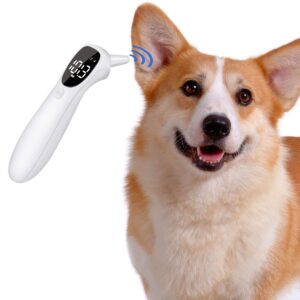
Much easier to use the ear thermometer.
A rectal thermometer is the only accurate way to take a dog’s temperature. Have some lube on hand to make the process a bit more comfortable.
That being said, just in case, have an instant ear thermometer in your kit as well. A normal temperature for a dog is 101.5 degrees, plus or minus one degree.
13. A Muzzle

As painful as it is, sometimes its necessary to muzzle your dog.
Hopefully, you’ll never have to use it, but when your dog is seriously injured, they might not want to be moved or handled.
Even if your dog wouldn’t bite in normal circumstances, if he’s been hit by a car or just had a seizure, it could bite out of fear, pain, or confusion.
A muzzle is a tool to keep both of you safe. If you don’t have a muzzle during an emergency, your leash will work in a pinch.
14. Styptic Powder

Owner is cutting the toenails of the dog
This powder is used to make blood clot quickly. It should never be used on flesh wounds because it burns quite a bit. Instead, it’s great for nails that are bleeding because they’ve been cut too short.
Quick Recap & Dog CPR
So just to quickly recap on what you would need in your dog’s first aid kit:
- A First Aid Book
- Latex Gloves
- Tick Removal Tweezers
- Cotton Balls
- Gauze Pads/Squares & Rolls
- Self-Adhering Bandage Wrap
- Wound Spray
- Elizabethan Collar
- Saline Solution
- Antihistamine
- Hydrogen Peroxide
- Ear & Rectal Thermometer
- A Muzzle
- Styptic Powder
This is the first aid kit all dog owners need to have.
You can get most of these items in a local pet shop and/or a pharmacy. But if you are keen on saving a few bucks just plan ahead and get them online. After all what’s the point of doing your own DIY kit if don’t save a few dollars in the process.
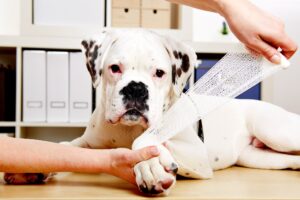
A bulldog getting arm wrapped with gauze roll
No matter how you make your k9 medical kit, or whether you buy one online, or from a dog supply store, you should know what everything is for and how to use it. Knowing how to use everything is the best way to properly care for your dog in an emergency.
If this list has made you quite nervous, you should consider taking a first aid training course that will include dog CPR classes.
Having hands-on training will make you feel more comfortable using the tools in your k9 first aid kit and feel better prepared in the event of a K9 emergency.
CPR might not be something you can put in your kit but you should bag this skill if you own a dog.
Courses are offered in most towns and held throughout the year by seasoned vets or vet techs. You’ll learn how to stop bleeding, administer medication, perform CPR on a dog, and the steps you need to take during events like a snake bite or if your dog was hit by a car.
Having hands-on training will give you the confidence you need to act logically during a medical emergency situation.
Whatch this video of a trainer saving a dog’s life:

